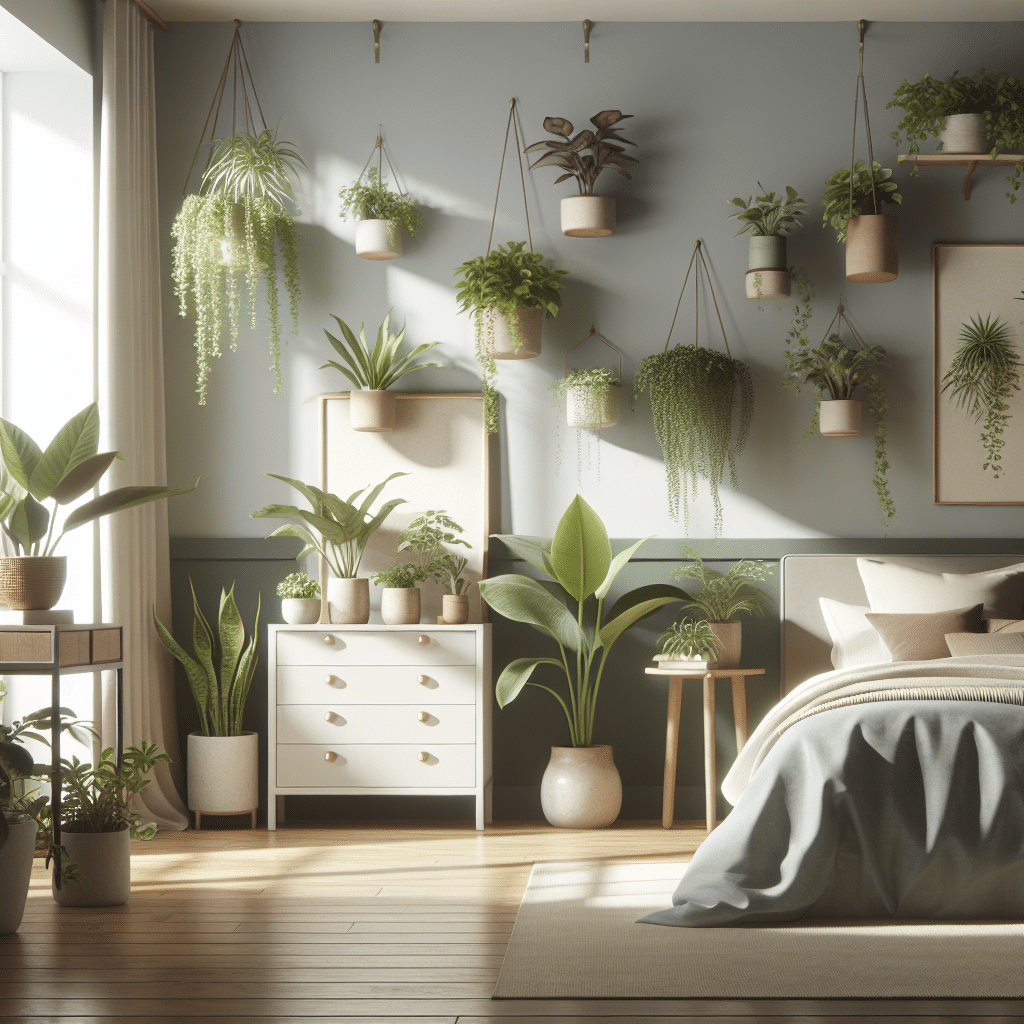The Benefits of Air-Purifying Plants for Your Bedroom
Understanding How Air-Purifying Plants Work
Air-purifying plants are more than just aesthetically pleasing; they serve a critical function in enhancing indoor air quality. They absorb pollutants and carbon dioxide while releasing oxygen through a process known as photosynthesis. NASA’s Clean Air Study identified several houseplants that effectively filter common indoor toxins such as formaldehyde, benzene, and xylene.
Top Air-Purifying Plants for a Serene Bedroom Atmosphere
1. Snake Plant (Sansevieria trifasciata)
- Air-Purifying Benefits: The snake plant is renowned for its ability to convert carbon dioxide into oxygen even at night, unlike most plants. This makes it a perfect choice for bedrooms.
- Care Requirements: Thrives in low light and requires minimal watering. Just water every couple of weeks.
- Design Aspect: Its tall, stiff leaves add vertical interest and fit well in modern decor.
2. Peace Lily (Spathiphyllum)
- Air-Purifying Benefits: Recognized for removing toxins such as ammonia, benzene, and formaldehyde, the peace lily also acts as a natural humidifier.
- Care Requirements: Prefers indirect sunlight and should be watered when the soil feels dry to the touch.
- Design Aspect: Its elegant white blooms provide a soft visual touch, enhancing a serene bedroom atmosphere.
3. Spider Plant (Chlorophytum comosum)
- Air-Purifying Benefits: Effective at filtering carbon monoxide and other pollutants, the spider plant is a hardy choice for bedrooms.
- Care Requirements: Thrives in a variety of conditions, making it easy to maintain. Water when the top inch of soil dries out.
- Design Aspect: Its arching leaves and baby plantlets create a playful look, ideal for hanging baskets.
Enhancing Serenity with Aromatic Air-Purifying Plants
4. Lavender (Lavandula)
- Air-Purifying Benefits: While primarily known for its calming scent, lavender also helps reduce indoor air pollutants.
- Care Requirements: Requires bright light and well-drained soil. Water sparingly, allowing the soil to dry out.
- Design Aspect: The soothing purple flowers add color and a fragrant ambiance to your night space.
5. Rosemary (Rosmarinus officinalis)
- Air-Purifying Benefits: Rosemary not only purifies the air but also has antidepressant effects, contributing to a peaceful environment.
- Care Requirements: Grow in bright light and well-draining soil. Keep it slightly dry between watering.
- Design Aspect: Its bushy form adds a touch of greenery and texture.
Low-Maintenance Air-Purifying Options
6. Pothos (Epipremnum aureum)
- Air-Purifying Benefits: Pothos is a standout in air purification, effectively removing pollutants such as formaldehyde and xylene.
- Care Requirements: Thrives in low light. Water when the soil is dry—low maintenance makes it ideal for busy lifestyles.
- Design Aspect: Its trailing vines look beautiful in hanging pots or trained along shelves.
7. ZZ Plant (Zamioculcas zamiifolia)
- Air-Purifying Benefits: The ZZ plant is particularly effective at filtering out toxins while being resilient to neglect.
- Care Requirements: Can survive in low light and infrequent watering, making it perfect for beginners.
- Design Aspect: Its glossy leaves add a modern, chic vibe to any bedroom.
Combining Aesthetics and Functionality
8. Fiddle Leaf Fig (Ficus lyrata)
- Air-Purifying Benefits: Known for its ability to improve air quality by filtering toxins and producing oxygen, the fiddle leaf fig is a popular choice for larger spaces.
- Care Requirements: Thrives in bright, indirect light and needs watering when the top inch of soil is dry.
- Design Aspect: Its large, dramatic leaves create a striking focal point in the bedroom.
9. Dracaena (Dracaena marginata)
- Air-Purifying Benefits: Dracaena varieties are effective at removing toxins like formaldehyde and trichloroethylene while promoting indoor wellness.
- Care Requirements: Prefers moderate to bright indirect light and should be watered when the soil is dry.
- Design Aspect: Its tall stems and spiky leaves add a unique silhouette to any decor.
Tips for Maintaining Your Air-Purifying Plants
- Light: Determine the appropriate light requirements for each plant and place them accordingly. Use sheer curtains to diffuse harsh sunlight if necessary.
- Watering: Overwatering is one of the most common mistakes. Always check the moisture level of your soil before watering.
- Fertilization: Consider fertilizing during the growing season (spring and early summer) to promote healthy growth and enhance air-purifying qualities.
- Dusting: Clean the leaves regularly to prevent dust build-up, which can block light absorption and reduce air purification efficiency.
Creating a Cozy Atmosphere
Pairing air-purifying plants with soft furnishings, calming colors, and soothing scents can enhance your bedroom’s tranquility. Consider using natural fibers and earth tones to complement the green hues of your plants. Utilize plant stands or shelves to create levels in your decor, adding depth and visual interest.
Incorporating air-purifying plants into your bedroom not only promotes a healthier living environment but also enhances the overall atmosphere, making it a serene and restful space. With a variety of options suitable for different aesthetics and care routines, embracing greenery in your sleeping area can transform it into a calming haven.
